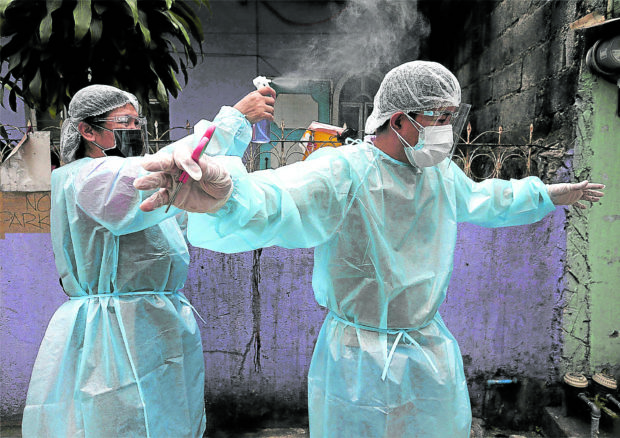Coronavirus infections also rising outside Metro Manila

DISINFECTING A VILLAGE Health workers spray disinfectant as they make their way through Barangay 628 Zone 63 in Santa Mesa district, Manila, which has been placed on lockdown for four days because of an increase in COVID-19 cases in the village. Coronavirus infections are also rising outside Metro Manila, the independent research group OCTA reported on Wednesday. —RICHARD A. REYES
MANILA, Philippines — An upward trend in the number of new COVID-19 cases has been observed outside Metro Manila, with several cities in Calabarzon and the Visayas showing a rise in the daily attack rate, an independent group of researchers said on Wednesday.
Daily attack rate refers to the number of new infections for every 100,000 people.
In an online forum on Wednesday, Guido David of OCTA Research reported the group’s latest findings, which identified 25 cities with the most number of new COVID-19 cases.
Ten of the cities are outside Metro Manila.
The city with the highest number of new cases, averaged between March 10 and 16, is Quezon City, with 443 cases.
Article continues after this advertisementThe figure represents a 93 percent increase from Quezon City’s daily average recorded in the previous week, David said.
Article continues after this advertisementFollowing Quezon City are Manila, Pasay and Makati in Metro Manila, and Cebu in the Visayas.
‘Interest rate’
Notable is the increasing trend in Bacoor City and Imus City in Cavite province, which showed 52 percent and 92 percent increases, respectively, from last week.
Antipolo City has 50 new cases every day, an increase of 78 percent, while Cainta has 49 new cases daily or a 128 percent jump. Both Antipolo City and Cainta are in Rizal province.
“It’s not only happening in [Metro Manila], but [also] in parts of Rizal and parts of Cavite,” David said.
In Dasmariñas City, Cavite, the daily average case has risen to 34, a 138 percent increase from last week, while Santiago in Isabela has an average of 35 cases daily from almost zero last week.
David said the team had been sharing its projections to help policymakers decide the steps to take to curb the trend.
Aside from the daily attack, he said, projections are plotted based on the case reproduction or the speed of transmission, a process he likened to interest rate.
“[But] if your interest rate does not change, if the [case] reproduction rate does not change,” he said, the number of cases will hit 6,000 daily by April 1.
This could rise to 16,000 new cases daily by April 16, he said.
Variants
But if the more contagious variants of SARS-CoV-2, the coronavirus that causes COVID-19, become the dominant bugs, cases could grow up to 28 times in just a month, the Department of Health (DOH) said on Wednesday.
Dr. Alethea de Guzman of the DOH epidemiology bureau told an online briefing that while only 6.6 percent of the total sequenced samples in the country had been confirmed to be variants of SARS-CoV-2, there could be a multiplier effect on infections if these variants spread and became dominant.
If that happens, De Guzman said, cases will increase up to 28 times and that will overwhelm the country’s health-care system.
Three variants of the COVID-19 coronavirus have been detected in the Philippines—the B.1.1.7 (also called UK variant because it was first found in the United Kingdom), B.1.135 (South Africa variant), and P.1 (Brazil variant).
The World Health Organization refers to these lineages of SARS-CoV-2 as “variants of concern” because of their high transmissibility.
The DOH reported on Saturday that P.1 had been detected in a Filipino migrant worker who had returned from Brazil.
So far, the Philippines has 177 UK and 90 South Africa variant cases and one case of the Brazil variant, the DOH said.
De Guzman said 27 percent of all the cases were international travelers—73 returning migrant workers and one foreigner.
Limit international travel
The DOH supports calls for limits to international travel to arrest the spread of the variants, she said.
“Give us time to bring these numbers down,” De Guzman said, adding that 27 percent was significant.
De Guzman also said the current rise in COVID-19 cases was already similar to the peak of infections last year.
Infections peaked at 4,000-5,000 in late July and early August last year, forcing exhausted health workers to call for a “timeout,” which prompted the government to place Metro Manila on strict quarantine.
On Wednesday, the DOH logged 4,387 additional coronavirus infections, bringing the number of confirmed COVID-19 cases in the country to 635,698 overall.
The DOH reported that 374 more patients had recovered, pushing the total number of COVID-19 survivors to 561,099. It said 18 other patients had died, raising the death toll to 12,866.
Those deaths and recoveries left the country with 61,733 active cases, of which 93.0 percent were mild, 3,8 percent asymptomatic, 0.68 moderate, 13 percent severe, and 1.2 percent critical.
—WITH A REPORT FROM PATRICIA DENISE M. CHIU
For more news about the novel coronavirus click here.
What you need to know about Coronavirus.
For more information on COVID-19, call the DOH Hotline: (02) 86517800 local 1149/1150.
The Inquirer Foundation supports our healthcare frontliners and is still accepting cash donations to be deposited at Banco de Oro (BDO) current account #007960018860 or donate through PayMaya using this link.